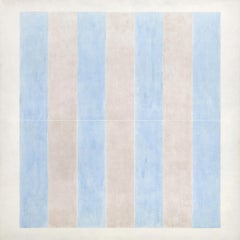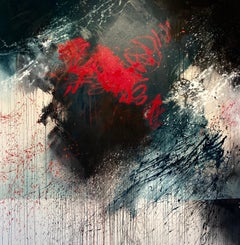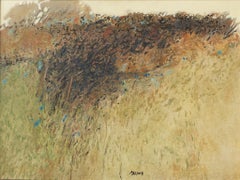Agnes Martin Abstract Paintings
American, 1912-2004
Born on a farm in rural Saskatchewan, Canada, Agnes Martin immigrated to the United States in 1932 in the hopes of becoming a teacher. After earning a degree in art education, she moved to the desert plains of Taos, New Mexico, where she made abstract paintings with organic forms, which attracted the attention of renowned New York gallerist Betty Parsons, who convinced the artist to join her roster and move to New York in 1957. There, Martin lived and worked on Coenties Slip, a street in Lower Manhattan, alongside a community of artists—including Robert Indiana, Ellsworth Kelly, and Jack Youngerman—who were all drawn to the area’s cheap rents, expansive loft spaces and proximity to the East River. Harbor Number 1 (1957), one of Martin’s earliest New York paintings, combines the geometric abstraction of her earlier Taos work with the newfound inspiration of the harbor landscape, evident in her choice of blue-gray palette.
Over the course of the next decade, Martin developed her signature format: six by six foot painted canvases, covered from edge to edge with meticulously penciled grids and finished with a thin layer of gesso. Though she often showed with other New York abstractionists, Martin’s focused pursuit charted new terrain that lay outside of both the broad gestural vocabulary of Abstract Expressionism and the systematic repetitions of Minimalism. Rather, her practice was tethered to spirituality and drew from a mix of Zen Buddhist and American Transcendentalist ideas. For Martin, painting was “a world without objects, without interruption… or obstacle. It is to accept the necessity of … going into a field of vision as you would cross an empty beach to look at the ocean.”1
In 1967, at the height of her career, Martin faced the loss of her home to new development, the sudden death of her friend Ad Reinhardt, and the growing strain of mental illness; she left New York, and returned to Taos, where she abandoned painting, instead pursuing writing and meditation in isolation. Her return to painting in 1974 was marked by a subtle shift in style: no longer defined by the delicate graphite grid, compositions such as Untitled Number 5 (1975) display bolder geometric schemes—like distant relatives of her earliest works. In these late paintings, Martin evoked the warm palette of the arid desert landscape where she remained for the rest of her life.to
1
Overall Width
to
Overall Height
to
1
1
1
1
1
1
1
1
6
666
627
362
342
1
1
Artist: Agnes Martin
Untitled No. 7
By Agnes Martin
Located in Palm Desert, CA
"Untitled No. 7" is an abstract Post War acrylic, pencil and gesso on canvas by Agnes Martin in 1974. The artwork is 72 x 72 inches and, with the frame, is 72 3/8 x 72 3/8 x 1 1/2 in...
Category
20th Century Post-War Agnes Martin Abstract Paintings
Materials
Gesso, Canvas, Acrylic, Pencil
Price Upon Request
Related Items
Across the Universe - Contemporary Abstract Painting
Located in Carmel, CA
Beth Shields is a distinguished abstract artist whose work has captivated collectors and audiences worldwide. Based in Santa Cruz, California, Beth has de...
Category
2010s Contemporary Agnes Martin Abstract Paintings
Materials
Gesso, Canvas, Acrylic, Graphite
"Carmel California" Impressionist Landscape
By Forrest Moses
Located in Austin, TX
By Forrest Moses (American, b. 1934)
Carmel California, 1967
Medium: Oil on Canvas
Size: 18" x 24"
Framed Size: 22.5" x 28.5"
About the Artist:
Fo...
Category
1960s Post-War Agnes Martin Abstract Paintings
Materials
Canvas, Oil
Infinity Field (Jerusalem Series III #1)
By Theodoros Stamos
Located in Austin, TX
Waterline Fine Art, Austin, TX is pleased to present the following work:
Acrylic on canvas. Signed lower left; signed, titled, and dated verso.
65.75 x 50.25 in.
67.25 x 51.75 in. (framed)
Custom framed in a maple floater with a matte white finish.
Provenance
Takis Efstathiou, PTE Fine Arts, New York
Private Collection, New York
Theodoros Stamos is heralded as one of the few abstract painters who bridged the New York School’s first and second generations. His age, in particular, afforded him this unique position, as he was the youngest member of the “Irascibles,” the core group of fifteen New York School painters publicized by Nina Leen...
Category
1980s Post-War Agnes Martin Abstract Paintings
Materials
Canvas, Acrylic
Warm Beach (#108)
By Joyce Kozloff
Located in Austin, TX
Acrylic and graphite on canvas. Signed and titled verso.
59 x 58.5 in.
61 x 60.25 in. (framed)
Custom framed in a maple floater with a polyurethane clear coat finish.
Provenance
B...
Category
1970s Post-War Agnes Martin Abstract Paintings
Materials
Canvas, Acrylic, Graphite
Love in Black and Gold - Original Acrylic on Canvas with Quartz
Located in Soquel, CA
Love in Black and Gold - Original Acrylic on Canvas with Quartz
Multicolored, iridescent abstract composition by Judith W Winslow (JW) (American, 1943-2023). This piece is textured ...
Category
Late 20th Century Post-War Agnes Martin Abstract Paintings
Materials
Acrylic, Laid Paper
$2,080 Sale Price
35% Off
H 47.5 in W 35.25 in D 1.5 in
Seated Nude in Blue - Original Abstract Expressionist on Canvas
Located in Soquel, CA
Seated Nude - Original Abstract Expressionist on Canvas
Abstract expressionist figurative composition of a woman in Blue by California artist Harald "Harry" Dry Schmidt (American, 1...
Category
1970s Post-War Agnes Martin Abstract Paintings
Materials
Canvas, Oil, Stretcher Bars
$2,120 Sale Price
20% Off
H 36 in W 30 in D 2 in
Color Block Geometric Abstract in Acrylic on Canvas
Located in Soquel, CA
Color Block Geometric Abstract in Acrylic on Canvas
Bright, balanced composition by an unknown artist (20th Century). This piece is minimalist in design but maximalist in color - bo...
Category
21st Century and Contemporary Post-War Agnes Martin Abstract Paintings
Materials
Canvas, Acrylic, Stretcher Bars
$1,800 Sale Price
20% Off
H 24 in W 48 in D 0.75 in
"Village Life" Oil Painting 12" x 20" inch (1987) by Fathi Afifi
By Fathi Afifi
Located in Culver City, CA
"Village Life" Oil Painting 12" x 20" inch (1987) by Fathi Afifi
Fathy Afifi is an Egyptian Postwar & Contemporary artist who was born in 1950.
He participated in local and interna...
Category
20th Century Post-War Agnes Martin Abstract Paintings
Materials
Canvas, Oil
$8,500
H 12 in W 20 in
Yellow Tail I
By Sherron Francis
Located in Austin, TX
Waterline Fine Art, Austin, TX is pleased to present the following work:
Acrylic and mixed media on canvas. Signed, titled, and dated verso.
40 x 76.5 in.
41.75 x 78.25 in. (framed)
Custom framed in a solid, unfinished maple floater.
Provenance
Watson/de Nagy & Company, Houston
Private Collection, New York
Sherron Francis was born in 1940, in Downers Grove, IL outside of Chicago. She originally enrolled at the University of Oklahoma, but later transferred to the Kansas City Art Institute to focus more on art. Initially, Francis' practice was focused on figurative art, with visiting professor and renowned modern realist Philip Pearlstein remarking on Francis’ draftsman acumen.
In the early 1960s, art dealers and gallerists from New York would visit the Institute to entice promising artists by offering scholarships and financial aid. Because such financial arrangements were only made for men, Francis had to persuade the school's leadership to allow for women to also be eligible for merit-based aid. Her advocacy was successful, and she ultimately graduated from the Kansas City Art Institute in 1963. She would then proceed to obtain her MFA from the University of Indiana, before assuming a teaching position at Eastern Michigan University.
In 1968, with only $300 on hand, Francis moved to 16 Waverly Place in SoHo, New York. The neighborhood was a hotbed for young AbEx artists of the day, and she quickly befriended the likes of Peter Reginato, Walter Darby Bannard, Michael Steiner, Peter Young, Peter Bradley...
Category
1970s Post-War Agnes Martin Abstract Paintings
Materials
Canvas, Mixed Media, Acrylic
Mid-Century Modern Extra-Large Red Abstract Oil Painting By Kai Lindemann
Located in Frederiksberg C, DK
An extra-large red abstract composition that invigorates the bystander with its powerful red and black color play. This oil painting is an exquisite example of a mid-century modern a...
Category
1960s Post-War Agnes Martin Abstract Paintings
Materials
Canvas, Oil
$5,700
H 35.83 in W 58.27 in D 1.19 in
Love in Spring at Big Sur California original Acrylic on Canvas
Located in Soquel, CA
Love in the Spring at Big Sur California original Acrylic on Canvas
Blossoms and flowers with Love (written on painting) and a spring mélange is a creation by Judith W Winslow (Amer...
Category
Early 2000s Post-War Agnes Martin Abstract Paintings
Materials
Canvas, Acrylic, Stretcher Bars
$2,752 Sale Price
20% Off
H 40 in W 30 in D 1 in
Untitled
Located in Austin, TX
Waterline Fine Art, Austin, TX is pleased to present the following work:
Oil on canvas. Signed, dated, and stamped verso.
23.75 x 24 in.
25 x 25.5 in. (framed)
Custom framed in a ...
Category
1970s Post-War Agnes Martin Abstract Paintings
Materials
Canvas, Oil
Agnes Martin abstract paintings for sale on 1stDibs.
Find a wide variety of authentic Agnes Martin abstract paintings available for sale on 1stDibs. You can also browse by medium to find art by Agnes Martin in acrylic paint, canvas, fabric and more. Much of the original work by this artist or collective was created during the 20th century and is mostly associated with the post-war style. Not every interior allows for large Agnes Martin abstract paintings, so small editions measuring 72 inches across are available. Customers who are interested in this artist might also find the work of Jack Roth, Leslie Luverne Anderson, and Arne Hiersoux. Agnes Martin abstract paintings prices can differ depending upon medium, time period and other attributes. On 1stDibs, the price for these items starts at $6,800,000 and tops out at $6,800,000, while the average work can sell for $6,800,000.
Artists Similar to Agnes Martin
Questions About Agnes Martin Abstract Paintings
- Why did Agnes Martin paint?1 Answer1stDibs ExpertApril 5, 2022Agnes Martin painted because of religious reasons. She viewed producing art as a form of spiritual meditation, borrowing from concepts of Zen Buddhism and American Transcendentalist philosophers. Shop a collection of Agnes Martin art from some of the world’s top sellers on 1stDibs.
- 1stDibs ExpertAugust 15, 2024Agnes Martin made around 450 paintings over the course of her life. However, no one knows the exact number. After she developed her grid system in 1960, Martin destroyed all of her earlier pieces, so it's possible that many works were lost. On 1stDibs, find a variety of Agnes Martin art from some of the world's top galleries.


